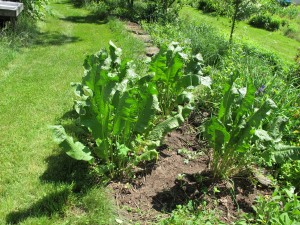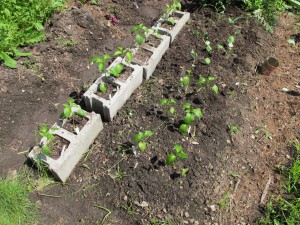Spicy, Zesty and Hot!
When I was a young man I lived in Africa and learned to love hot, spicy foods. In Cameroon, where I was a Peace Corps volunteer, the food was generally bland. Local folks ate ground corn, rice or cassava that was boiled up and only made interesting when served with a sauce made of leaves, spices and hot peppers – and very occasionally a little meat or fish. I was sometimes served pepper sauce so hot that it made me sweat and once I got uncontrollable hiccups along with the sweats. Habaneras? I bet some of the old boys could eat them like pickles. Now I grow hot peppers and horseradish to satisfy my need for hot and spicy.
Let’s start with peppers. Hot peppers would really rather be living in Mexico or Cameroon or even southern France. They do well in hot, dry climates and lousy soil. Or should I say, soil that is low in organic matter, and especially nitrogen. If you want to get peppers (and not just big plants and leaves), you should never give peppers fertilizer after they go in the ground. (I do give seedlings some liquid fish or seaweed fertilizer when they are growing indoors).
I grow a number of kinds of hot peppers most years. My favorite is one called the Espelette pepper, a name that the French government lists as controlled (sort of like the word “champagne” which can only be used to refer to bubbly wine from certain villages). True Espelettes come from just 11 villages in southwest France – and from Cornish Flat, NH, of course. The French dry Espelette peppers and coarsely grind them into a powder. They are about the same level of spiciness as jalapenos, about 4,000 Scoville units. Here in the States, Espelette powder sold on the internet costs about $8/oz. I’ve never seen it for sale in a store.
Chatting about gardening in my favorite restaurant, my server told me that she grows her peppers in cement blocks. She said that she fills the holes in the blocks with soil and plants into the blocks. Since the cement absorbs the sun’s heat, they do better than those grown in the soil, she said.
I knew that peppers like to be grown in close proximity to other peppers – though I have never understood why – and each cement block provides space for two peppers that are quickly touching leaves. So this year I’m conducting a comparison – some in the soil, others next to them in blocks. I made a mix of potting soil and compost to fill the blocks because I think straight garden soil would compact and stifle the roots. I’ll report back in the fall.
Then there is horseradish. Horseradish is in the cabbage family, but unlike its cousins, it is the root, not the leaves, that you eat. And unlike other crucifers, horseradish is not started by seed, but by planting a cutting. The Johnny’s Selected Seeds catalog, one of very few that offers cuttings, explains that the seeds are not viable. They ship cuttings in April, “after danger of freezing in transit has passed.” I called them, and they are currently out of stock until next spring. But you can also get cuttings from a friend and plant some now.
 To prepare a cutting, dig up a root, cut off the leaves, and use the top 2 inches of the root to re-plant. Bury the starts about 2 inches deep and 12 inches apart. Prepare a horseradish bed by working in some well rotten manure or compost. That will improve soil texture and keep the soil looser – for ease in future harvesting. You can begin harvesting a year or two after planting.
To prepare a cutting, dig up a root, cut off the leaves, and use the top 2 inches of the root to re-plant. Bury the starts about 2 inches deep and 12 inches apart. Prepare a horseradish bed by working in some well rotten manure or compost. That will improve soil texture and keep the soil looser – for ease in future harvesting. You can begin harvesting a year or two after planting.
Horseradish does best in well drained soil, but really will grow anywhere. It will be most vigorous in full sun, but 4 hours is plenty. Horseradish, which is essentially a weed, doesn’t need high levels of nitrogen, phosphorus or potassium.
Once established, horseradish roots go down two feet or more into the soil. Because the roots branch and they are brittle, one can never get all the roots out. Even a scrap of the root will re-sprout, so the plants are there for life. Horseradish is as persistent as it is piquant. It doesn’t spread fast, but it spreads. I keep my patch under control with the lawnmower – it can’t spread into the lawn without being cut down.
To harvest, loosen the soil around a plant, either with a garden fork or a drain spade. Drain spades have blades that are about 16 inches long and 5 inches wide, and are great for digging out deep-rooted things like horseradish and some persistent perennial weeds. A mature root will challenge even the strongest backs, so you may need to sever the root with your spade to remove it.
To make a horseradish sauce, peel the root, chop into pieces, and place in a blender with vinegar. The fumes are strong, so do it outside. Pulverize it, adding vinegar until it is the right consistency, and store in the fridge. Your own will be better than the store bought stuff.
Other than planting, horseradish needs no labor from a gardener until it’s time to harvest. Now if tomatoes and beans were so easy, I bet we’d all have bigger gardens!
Contact Henry at henry.homeyer @comcast.net. And visit his Web sites, www.Gardening-guy.com and www.henryhomeyer.com.



